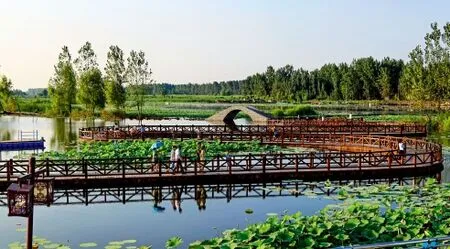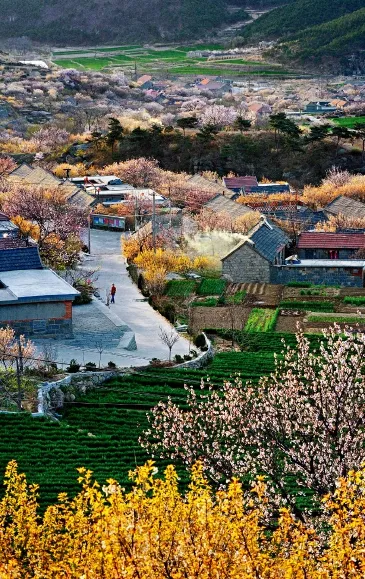Small Towns Mark The Way Forward
2017-05-11ByGuoBeibeiLuanXiaohuiWangTianyuandWangXuepeng
By Guo Beibei, Luan Xiaohui, Wang Tianyu and Wang Xuepeng
Small Towns Mark The Way Forward
By Guo Beibei, Luan Xiaohui, Wang Tianyu and Wang Xuepeng
China's Shandong Province sees the development of its characteristic small towns as a path toward improved growth
After seven of its towns were included in the list of characteristic Chinese towns at the end of 2016, Shandong named its first batch of provincial-level characteristic towns in early 2017. Meigui town in Pingyin, the holy Nishan town in Qufu and the tourist town of Yunzhou in Yuncheng, which features the Water Margin culture, are all listed. These small towns constitute a splendid landscape and present a marvelous stage for local economic development.
In Shandong, a town can be endowed with a unique image by the presence of a special product, a landscape or even a much-told tale, which can make it rich, populous and famous. The Department of Housing and Urban-Rural Development (DHURD) of Shandong Province announced it will build around 100 characteristic towns during the 13th Five-Year Plan period. In the future, more of these towns will come into people’s view.
Characteristic Towns Just Like People
Why is Shandong so confident in taking on such a big project —building 100 characteristic townsin five years?

Vineyards are a special area of focus in the development of characteristic towns in Shandong.
Small towns are just like people. Only those with cultural connotations and a unique temperament can pique one’s interest.
“When drafting the Plan on Building Shandong’s Characteristic Towns, the DHURD of Shandong has conducted full investigation and given adequate consideration to its development goals,” said Yang Jianwu, head of Shandong DHURD’s Division for Village and Town Development. “Building around 100 characteristic towns is based on multiple factors.”
According to Yang, Shandong’s local environment lends itself to the construction of such towns.
“Shandong has always attached importance to the characteristic development of its small towns,” Yang said. “In guiding their development and formulating related policies, the DHURD of Shandong requires them to focus on the integration of their features and environment based on special local resources. Meanwhile, the towns should deeply explore and carry forward traditional local cultures and create distinctive features. Currently, Shandong has built 331 state-level and provincial-level historical and cultural towns, tourist towns with unique landscapes and beautiful towns for people to live in, accounting for 30 percent of its total number of small towns. This has laid a good foundation for the development of characteristic towns.”
To achieve the beneficial experience of building such towns, experts from the DHURD of Shandong made four study trips to China’s eastern province of Zhejiang before and after the plan was drafted. They have visited nearly all of the 37 characteristic towns in the province, experiencing their charm. After summing up and absorbing their advantages, the experts set up the goals and requirements of building Shandong’s characteristic towns based on its actual conditions.
“As the goals, standards and requirements were established, we issued a notice which required all 17 cities to conduct a thorough investigation based on the standards provided and find towns matching these basic requirements,” Yang added. “Then, a list of 286 characteristic towns was provided to the department. Through comprehensive consideration, Shandong decided to establish around 100 characteristic towns. It had both the foundation and confidence to do it.”
In drafting the plan, the government stressed one point in particular — avoiding homogenization. According to Yang, Sun Wei, vice governor of Shandong, personally modified the plan, requiring that the characteristics of each town must be highlighted, and that work must be done based on objective laws instead of subjective judgments. That is to say, dif f erent characteristic towns can be built by taking advantage of dif f erent resources, leading industries and development paths. A characteristic town should have a distinct identity, including its special industries, characteristic landscapes, and more importantly, its unique cultural connotations. Such towns are meant to of f er people a unique atmosphere as soon as they enter. Small towns are just like people. Only those with cultural connotations and a unique temperament can pique one’s interest.
从表1可以看出,在扭动运动阶段GMs评估为PR的早产儿发展为行为多动冲动或攻击性行为等行为障碍性疾病的比例较高,尤其是在扭动阶段连续出现PR,后期发展为多动冲动或攻击性行为的比例较高,而在足月后扭动阶段前转归成N的早产儿,发展)成为多动冲动或攻击性行为的比例低。
Sustainable Development of Characteristic Towns
In the plan, it can be seen that being “industrially characteristic and strong, structurally new and dynamic, functionally integrated and united and externally exquisite and beautiful” is a generalized way to examine the characteristics of such towns. Therefore, it is not easy to establish a system of standards for their construction.
“Characteristics are the core elements of the towns and the most important in their industrial features,”explained Li Wei, vice president and secretary of the Society for Shandong’s Small Town Construction. “To find such characteristics, as well as highlight and magnify them, is the key to building the towns. Every characteristic town has its features and advantages. National policies shouldencourage the construction of more such towns, and equal attention should be paid to quality. We need to ensure that these towns can operate efficiently and drive economic restructuring and upgrading on a long-term basis. In this way, substantial development can be achieved.”
In Li’s opinion, in an ef f ort to guarantee the sustainable development of characteristic towns, construction patterns must be established first.
“The government used to play a major part in the construction of small towns,” Li said.“However, in the development of characteristic towns, the market should play a key role, and the government’s job is to implement ef f ective guidance. We should let the market play its decisive role in resource allocation and promote project construction depending on enterprises. Fiveyear development requires an investment of 3 billion yuan [US$440 million]. Since the government can’t provide that much money, we must rely on the market to attract social capital.”
Maintaining sustainability is every bit as important as funding, Li explained.
“We must be clear that the dominant industries must be emerging and green industries and traditional ones which can be optimized and improved, rather than coal, steel or other highly-polluting and highenergy consuming industries,”Li added. “The plan clearly states that we should focus on optimizing and improving traditional industries such as paper-making, brewing and textiles as well as developing ocean exploration, information technology, highend equipment, e-commerce, finance, energy conservation and environmental protection and other new industries, and green industries including tourism, cultural creativity, modern agriculture and eco-friendly furniture. The characteristic towns’ industries will have the space for sustainable development only if they are in line with policies on national strategic new industries or national industrial policies.”
It is also important to clarify government responsibilities. Li believes that although enterprises are the main body of the characteristic towns’construction, the government should also provide services by actively involving program designs, infrastructure facility and resource development, cultural connotation exploration and inheritance and ecological and environmental protection. Meanwhile, it should actively introduce third-sector bodies, provide e-commerce, software development, product promotion, technology incubation, market financing and other services for the enterprises, and build the characteristic towns into a new platform for mass innovation.

A night view of Liujiagou, a national characteristic town known for its beautiful natural environment.

The Weishan Lake Wetlands, part of a provincial-level characteristic town in Shandong.
Opening up New Paths
“Though Shandong’s characteristic towns are in their early stages of development, they have shown strong demonstration ef f ects and development potential,” said Wang Chang, deputy director and secretary of the Party committee of the Shandong Urban and Rural Planning Design Institute. “Building these townsis a beneficial area of exploration that can provide innovative ideas. It plays an essential role in promoting supply side reform, enhancing regional economic strength, boosting industrial development, improving resource utilization efficiency and stimulating innovative entrepreneurial energy.”

Characteristic towns include spectacular landscapes and present an opportunity for local economic development.
Shandong’s characteristic towns have found methods and impetus to attract capital.
“The leading industries should be in line with the policies on national strategic new industries or national industrial policies,” Wang added. “They can attract social capital only if they have sustainable development. Secondly, a good business environment is needed. The characteristic towns will not attract more investors and entrepreneurs unless there is a fair, orderly, unified and open market environment, as well as a transparent, honest and ef f ective government, a strict, standard, fair and civilized legal system, and a convenient and smooth service environment. And of course, a sound ecological environment is required. Now, people are paying more and more attention to the environment. If a place where they live and work has a healthy environment and pleasant scenery, it will enhance its charm and livability.”
Building characteristic towns is proven to lead to local economic development and brings tangible benefits to people.
“For the development of both national characteristic towns and provincial-level ones, our requirement is that a recreational path must be built,” said Chen Zhenhua, a researcher with the Shandong DHURD’s Division for Village and Town Development.“A park, greenbelt, square or entertainment venue must be provided for people within a 3-5 minute walk at any point in town. Also, there needs to be a sense of cultural identity. A characteristic town is expected to deeply explore its traditional culture and carry it forward during its development. Some folk activities can be held regularly to attract people. Ef f orts in exploring and carrying forward the local culture can help people develop a sense of identity with it. In return, they will involve themselves in the town’s construction more actively.”
Yang added that Shandong’s planning is looking toward the long term.
“We are always looking forward to the construction of characteristic towns,” Yang said.“In the next five years, Shandong will open up a new path of developing towns of dif f erent sizes.”
The Shandong government has made the decision to implement the “1310 Project”, developing characteristic towns of three dif f erent sizes during the 13th Five-Year Plan period. Its first aim is to build 10 towns, the facilities and functions of which are relatively complete. In each town, population is expected to exceed 100,000 and financial revenue is expected to exceed 1 billion yuan (US$150 million). Later on, it plans to develop 30 key pilot towns with strong economic influence, populations of 50,000 and financial revenue of 500 million yuan (US$75 million). Finally, around 100 characteristic towns will be created to serve as new regional economic growth points.
As the 1310 Project is carried out, equal attention should be paid to the development of other towns. For small towns with rich historical, cultural and tourist resources, the government should attach importance to historical and cultural inheritance based on the cultural factors. It should also explore natural wonders and implement protective development and construction to stimulate the regenerative vigor of such developments.
For the towns with certain industrial bases, they should develop leading industries based on the “One Town One Product”model, as well as guide enterprise to achieve transformation and upgrading so as to improve local revenues. For other towns, the development goals are to strengthen ecological and environmental protection, improve infrastructure and public service facilities, create a beautiful and favorable living environment and promote development potential.
